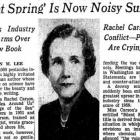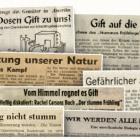The Personal Attacks on Rachel Carson as a Woman Scientist
Miss Rachel Carson’s reference to the selfishness of insecticide manufacturers probably reflects her Communist sympathies, like a lot of our writers these days. We can live without birds and animals, but, as the current market slump shows, we cannot live without business. As for insects, isn’t it just like a woman to be scared to death of a few little bugs! As long as we have the H-bomb everything will be O.K.
—Letter to the editor of the New Yorker (cited in Smith 2001, 741)
Opponents of Silent Spring attacked Rachel Carson personally. They accused her of being radical, disloyal, unscientific, and hysterical. In 1962, at the height of the Cold War with the Soviet Union, criticism of the United States struck many as unpatriotic or sympathetic with communism. Former Secretary of Agriculture Ezra Taft Benson wrote privately to former President Dwight Eisenhower that Carson was “probably a communist” (Lear 1997, 429). Velsicol’s threatening letter to Houghton Mifflin argued that if the public demanded elimination of pesticides, “our supply of food will be reduced to East-curtain parity [i.e., as inefficient as the Communist nations east of the ‘Iron Curtain’]” (Smith 2001, 736).

The great editorial cartoonist Bill Mauldin of the Chicago Sun-Times illustrates the gender dimension of the controversy over Carson and Silent Spring. In this 27 October 1963 cartoon he pairs her with Jessica Mitford, author of The American Way of Death, a scathing indictment of the funeral home industry. Men from both industries have been flattened under the platens of the women’s typewriters. Illustration by Bill Mauldin.
The great editorial cartoonist Bill Mauldin of the Chicago Sun-Times illustrates the gender dimension of the controversy over Carson and Silent Spring. In this 27 October 1963 cartoon he pairs her with Jessica Mitford, author of The American Way of Death, a scathing indictment of the funeral home industry. Men from both industries have been flattened under the platens of the women’s typewriters. Illustration by Bill Mauldin.
© 1963 Bill Mauldin. Courtesy of Bill Mauldin Estate LLC.
The copyright holder reserves, or holds for their own use, all the rights provided by copyright law, such as distribution, performance, and creation of derivative works.
If not an outright Communist, surely Carson was linked to “food faddists” or, as William Darby of the Vanderbilt University School of Medicine characterized them, “the organic gardeners, the anti-fluoride leaguers, the worshippers of ‘natural foods,’ and those who cling to the philosophy of a vital principle, and pseudo-scientists and faddists” (Smith 738). Another decade or two would pass before most Americans considered organic gardening or natural foods as fit for anyone but cranks and misfits.
Allegations that Carson was just a hysterical woman appeared both in the pages of chemical and agricultural trade journals as well as in the popular press. Women were imagined to be less rational, more emotional, and more sentimental than men, who could be relied upon to study the issues dispassionately and propose rational solutions. An agricultural expert told a reporter at the Ribicoff hearings, “You’re never going to satisfy organic farmers or emotional women in garden clubs” (Graham 1970, 88). In his letter to Eisenhower, Benson wondered why a “spinster was so worried about genetics” (Lear 1997, 429).
As Carson had no institutional affiliation, she was dismissed as an amateur who did not understand the subject like a professional scientist would, or who distorted or misread the science. To her critics, Carson’s frequent use of terms like “nature,” “natural,” and “balance of nature” identified her as a mere sentimental nature lover or a pantheist like Ralph Waldo Emerson or Henry David Thoreau. Reviews in Time, U.S. News and World Report, and even Sports Illustrated took her to task. The reviewer in Time, for example, criticized her “emotion-fanning words” and characterized her argument as “unfair, one-sided, and hysterically overemphatic.” He traced her “emotional and inaccurate outburst” to her “mystical attachment to the balance of nature” (Brooks 1989, 297).
Even inoffensive public portraits of Carson showed her in more domestic rather than scientific settings. Life magazine published a story about her accompanied by photos of her talking with children while on a nature walk or watching birds with a group of Audubon Society members. Dressed like a housewife and surrounded by children and “bird people,” Carson projected an image of a teacher or stay-at-home mother, although the picture on the first page of the article showed her at a microscope. Carson, said the story, “is unmarried but not a feminist (‘I’m not interested in things done by women or by men but in things done by people’)” (105).
















